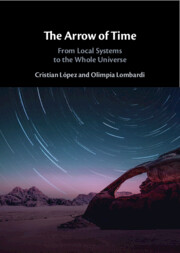Book contents
- The Arrow of Time
- The Arrow of Time
- Copyright page
- Contents
- Contributors
- Preface
- Acknowledgments
- Part I Local Systems
- 1 The Direction of Time: From the Cosmos to Local Systems
- 2 Thermodynamics with and without Irreversibility
- 3 Thermodynamics without Time
- Part II The Arrow of Time and Philosophical Issues
- Part III The Arrow of Time and Time-Reversal Invariance
- Part IV The Whole Universe
- Index
1 - The Direction of Time: From the Cosmos to Local Systems
from Part I - Local Systems
Published online by Cambridge University Press: 28 October 2025
- The Arrow of Time
- The Arrow of Time
- Copyright page
- Contents
- Contributors
- Preface
- Acknowledgments
- Part I Local Systems
- 1 The Direction of Time: From the Cosmos to Local Systems
- 2 Thermodynamics with and without Irreversibility
- 3 Thermodynamics without Time
- Part II The Arrow of Time and Philosophical Issues
- Part III The Arrow of Time and Time-Reversal Invariance
- Part IV The Whole Universe
- Index
Summary
There is a long-cherished hope, which has its origins in the work of Boltzmann, that all that we are going to need to do in order to account for all the of the differences there are between the past and the future is to add to the fundamental time-reversal-symmetric dynamical laws, and to the standard statistical-mechanical probability-measure over the space of possible fundamental physical states, a simple postulate – a so-called “past hypothesis” – about the initial microstate of the universe as a whole. And there are various widespread and perennial sorts of puzzlement about how a hope like that can even seriously be entertained – puzzlements (that is) about how it is that the macrocondition of the universe 15 billion years ago, all by itself, can even imaginably be up to the job of explaining so much about the feel, today and on Earth, of the passing of time. I want to try to alleviate those puzzlements here. I will begin with a number of very general observations – and then, by way of illustration, I will present a new and detailed analysis of how it is that a simple pendulum clock invariably arranges to turn its hands clockwise in the temporal direction that points away from the Big Bang.
Information
- Type
- Chapter
- Information
- The Arrow of TimeFrom Local Systems to the Whole Universe, pp. 3 - 11Publisher: Cambridge University PressPrint publication year: 2025
Accessibility standard: WCAG 2.1 AA
Why this information is here
This section outlines the accessibility features of this content - including support for screen readers, full keyboard navigation and high-contrast display options. This may not be relevant for you.Accessibility Information
Content Navigation
Allows you to navigate directly to chapters, sections, or non‐text items through a linked table of contents, reducing the need for extensive scrolling.
Provides an interactive index, letting you go straight to where a term or subject appears in the text without manual searching.
Reading Order & Textual Equivalents
You will encounter all content (including footnotes, captions, etc.) in a clear, sequential flow, making it easier to follow with assistive tools like screen readers.
You get concise descriptions (for images, charts, or media clips), ensuring you do not miss crucial information when visual or audio elements are not accessible.
Visual Accessibility
You will still understand key ideas or prompts without relying solely on colour, which is especially helpful if you have colour vision deficiencies.
Structural and Technical Features
You gain clarity from ARIA (Accessible Rich Internet Applications) roles and attributes, as they help assistive technologies interpret how each part of the content functions.
